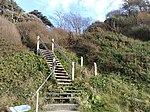Warden Point Battery

Warden Point Battery is a battery on the Isle of Wight begun in 1862, that was originally armed with 7-inch and 9-inch rifled muzzle loaders on barbette mountings. It was built in the 1890s for 9.2-inch breech loader guns. In use until 1936, and in World War II as a command post and searchlight battery. The battery was a regular polygon with central caponier on the landward side, and flanking caponiers at the North and South corners. The central caponier and North -East loopholed wall remain. The site spent a considerable number of years after the second world war as a holiday camp. Following the closure of that, the housing estate was started. Unconfirmed information from the builders on a visit to the site suggests that some of the historic features will be retained. These include the main wall and entrance arch to the battery and some of the concrete emplacements. The latter will be built over, but protected so that they can be "re-discovered" if and when the newer buildings are demolished. At time of writing, the building work has been suspended.It is now a Grade II Listed Building.
Excerpt from the Wikipedia article Warden Point Battery (License: CC BY-SA 3.0, Authors, Images).Warden Point Battery
Fort Warden Road,
Geographical coordinates (GPS) Address Nearby Places Show on map
Geographical coordinates (GPS)
| Latitude | Longitude |
|---|---|
| N 50.68805 ° | E -1.54411 ° |
Address
Fort Warden Road
PO39 0DA , Middleton
England, United Kingdom
Open on Google Maps









